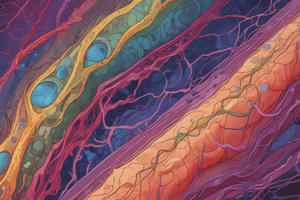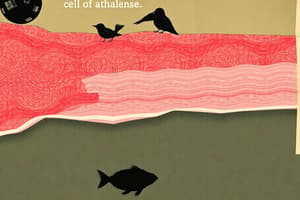Podcast
Questions and Answers
Intermediate filaments are primarily responsible for cell-cell attachment in epithelial tissue.
Intermediate filaments are primarily responsible for cell-cell attachment in epithelial tissue.
False (B)
Cadherins are transmembrane proteins that require Ca2+ for cell-cell interaction.
Cadherins are transmembrane proteins that require Ca2+ for cell-cell interaction.
True (A)
Intermediate filaments play a crucial role in cell motility.
Intermediate filaments play a crucial role in cell motility.
False (B)
Desmosomes provide strong mechanical attachment between adjacent cardiac muscle cells.
Desmosomes provide strong mechanical attachment between adjacent cardiac muscle cells.
Tight junctions create pathways for molecules to pass between epithelial cells.
Tight junctions create pathways for molecules to pass between epithelial cells.
Epithelial tissue is strengthened by intermediate filaments that span the cytoplasm from one cell junction to another.
Epithelial tissue is strengthened by intermediate filaments that span the cytoplasm from one cell junction to another.
Epithelial tissues have a complex structure that includes a basal surface facing underlying tissues.
Epithelial tissues have a complex structure that includes a basal surface facing underlying tissues.
Actin filaments, also known as microfilaments, are more rigid than microtubules.
Actin filaments, also known as microfilaments, are more rigid than microtubules.
Cadherins play no role in the organization of epithelial tissues.
Cadherins play no role in the organization of epithelial tissues.
Cadherins are important for the establishment and maintenance of cell junctions.
Cadherins are important for the establishment and maintenance of cell junctions.
Gap junctions allow electrolytes and other molecules to flow directly between adjacent cells.
Gap junctions allow electrolytes and other molecules to flow directly between adjacent cells.
The diameter of intermediate filaments is significantly larger than that of microfilaments.
The diameter of intermediate filaments is significantly larger than that of microfilaments.
Catenin is a major transmembrane protein associated with tight junctions.
Catenin is a major transmembrane protein associated with tight junctions.
Microtubules are static structures that do not change their length during cellular processes.
Microtubules are static structures that do not change their length during cellular processes.
Microfilaments are involved in muscle contraction and cell division.
Microfilaments are involved in muscle contraction and cell division.
The nuclear lamina is formed by a type of microtubule.
The nuclear lamina is formed by a type of microtubule.
Cadherins are primarily involved in the formation of tight junctions between cells.
Cadherins are primarily involved in the formation of tight junctions between cells.
Intermediate filaments are composed of tubulin subunits.
Intermediate filaments are composed of tubulin subunits.
Organized structures of epithelial tissue contribute to the integrity of the tissue.
Organized structures of epithelial tissue contribute to the integrity of the tissue.
Cilia function as sensory organelles in only one type of epithelial tissue.
Cilia function as sensory organelles in only one type of epithelial tissue.
Centriole consists of 9 sets of 3 attached microtubules arranged to form a hollow cylinder.
Centriole consists of 9 sets of 3 attached microtubules arranged to form a hollow cylinder.
Microtubules play no role in intracellular transport within the cell.
Microtubules play no role in intracellular transport within the cell.
The primary function of microtubules is to form organelles like cilia and flagella.
The primary function of microtubules is to form organelles like cilia and flagella.
Microtubules are more rigid than actin filaments.
Microtubules are more rigid than actin filaments.
Study Notes
Epithelial Cell Junctions
- Tight junctions create impermeable or semipermeable barriers, primarily found in epithelial membranes.
- Gap junctions facilitate the passage of electrolytes and other molecules between cells, also known as communicating junctions.
- Adherens junctions provide strong mechanical attachment between cells, holding cells tightly together during expansion and contraction, such as in cardiac muscle.
- Desmosomes function as spot welds, holding cells together and preventing lateral tearing of tissues.
Adherens Junctions
- Cadherin is a major transmembrane protein in adherens junctions.
- Catenin is a major peripheral protein that connects cadherin to actin.
- Actin is the cytoskeletal anchor for adherens junctions.
Cadherins
- Transmembrane proteins with extracellular segments containing 5 domains.
- Ca2+-dependent dimers form between cadherin molecules on adjacent cells.
- Removing Ca2+ disrupts cell-cell interactions and causes cells to dissociate.
Cytoskeleton
- Microtubules are long, hollow cylinders composed of tubulin (alpha and beta tubulin) with a diameter of 25 nm.
- Microtubules are more rigid than actin filaments and often have one end attached to a microtubule-organizing center (MTOC) called a centrosome.
- Microtubules are involved in cellular division, organization of intracellular structure, intracellular transport, and ciliary and flagellar motility.
Centrosome
- Centrioles are made up of tubulin and form the major microtubule-organizing center (MTOC) in human cells.
- Centrioles consist of nine sets of three attached microtubules arranged in a hollow cylinder.
- Centrosomes organize microtubules in the cytoplasm and form the mitotic spindle during cell division.
Microfilaments
- Actin filaments (microfilaments) are two-stranded helical polymers of the protein actin, with a diameter of 5-9 nm.
- Microfilaments are less rigid than MT and are organized into linear bundles, two-dimensional networks, and three-dimensional gels.
- Microfilaments are most concentrated in the cell cortex, just beneath the plasma membrane.
- Microfilaments are essential for muscle contraction, cell motility, cell division, vesicle movement, cell signaling, and cell junction formation.
- Actin filaments and myosin work together for muscle movement.
Intermediate Filaments
- Intermediate filaments are fibrous structures with a diameter of around 10 nm, composed of various intermediate filament proteins.
- Intermediate filaments do not directly participate in cell motility.
- Nuclear lamina is formed by one type of intermediate filament, located just beneath the inner nuclear membrane.
- Intermediate filaments extend across the cytoplasm, providing mechanical strength to cells.
- Intermediate filaments strengthen epithelial tissue by spanning the cytoplasm from one cell-cell junction to another.
Studying That Suits You
Use AI to generate personalized quizzes and flashcards to suit your learning preferences.
Related Documents
Description
Explore the key types of epithelial cell junctions, including tight junctions, gap junctions, adherens junctions, and desmosomes. Understand the components and functions of adherens junctions, particularly the roles of cadherin and catenin in cell adhesion. This quiz will test your knowledge on these essential cellular structures.




